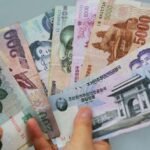You can also listen to this podcast on iono.fm here.
JEANETTE CLARK: South Africa’s small to medium enterprise [SME] sector is locked into a dynamic and demanding external environment. One report shows that in 2025 alone, about 37.5% of SMEs in South Africa reported being directly impacted by currency fluctuations, with a further 33.8% saying that they were feeling the indirect effects of the rand’s movements.
In this setting, treasury and foreign exchange risk management is no longer a specialised service for large corporates. It’s a critical link in the survival and growth chain for many SMEs and individuals.
Today we speak with Nico le Roux, managing director of Merchant West Treasury Solutions, to explore how the rand’s volatility influences the business environment for SMEs – and what practical strategies can be applied.
Nico, let’s start here. How does the rand’s volatility affect the business environment for SMEs in our country?
NICO LE ROUX: Well, Jeanette, it brings uncertainty, risk, but also opportunity. Let me just quickly explain.
A small business imports goods for which they get orders from clients in South Africa before they order the goods that they were going to sell, or are selling from the foreign country.
Therefore, they have to fix their selling price and their selling price commitments to their clients in South Africa before they actually pay for the goods that they are going to sell. That price is locked in US dollars or another foreign currency.
Now, as the foreign exchange markets move and the rand either depreciates or appreciates, it influences that purchase price.
For a company that is selling its goods in South Africa and needs to import them, as the rand weakens that purchase price in rand terms actually increases and the company’s profit will decrease. And if the rand appreciates, well, then the purchase price of the goods is actually going down and the profit of that company goes up.
There are, of course, risks that a company’s profit line is fully determined by the foreign exchange of the South African rand. That of course brings the risk that losses can be made, but [there is] also opportunity that additional profit to the bottom line can be made.
JEANETTE CLARK: It’s risk and its opportunity. So what strategies can SMEs implement to protect their business against the risk side and actually capitalise on the opportunities, as well as make the volatility work to their advantage?
NICO LE ROUX: Well, the simplest strategy for a business that imports and exports at the same time is to try and pair their income and expenses in the same foreign currency.
If a client exports, and their clients buy in US dollars, but they also buy goods in US dollars, it would be good if they can use that US dollar income to pay for the US dollar expenses. That’s called a natural hedge.
Then of course, the financial markets provide products and instruments that help businesses eliminate or limit risk of loss through the movement of exchange rates. Examples of these tools are forward contracts and options.
Now, forward contracts allow a business to fix an exchange rate for a certain amount on a specific future date; therefore the business knows exactly what that exchange rate and the price of those goods are going to be in the future.
Options, on the other hand, give a business the option to exchange a certain amount of currency in the future at a certain exchange rate. So an option is very much like taking out an insurance policy should the exchange rate fall into a very negative environment for the client.
By using these tools, risks can be limited for the actual business.
JEANETTE CLARK: So these tools are available, whether it’s a natural hedge or some of the other options that you’ve mentioned. But what is stopping SMEs from protecting themselves against the volatile rand?
NICO LE ROUX: Well, many of these SME owners, managers or operators just do not have enough knowledge of financial markets, the products and the actual tools used to protect their businesses.
Then secondly, time – business owners out there are running their operations and they just do not have time to sit behind computer screens, looking at the exchange rate for eight hours a day.
And then the third one which we see out there is normally cash flow. A business that uses these financial products – for example a forward contract, as mentioned earlier – must put a deposit down, normally called margin, which is generally 10% of the currency that is going to be exchanged in the future.
And many of these SMEs just do not have that cash to fund this deposit and therefore cannot use these tools.
JEANETTE CLARK: Right. At Merchant West Treasury Solutions, you are providing treasury outsourcing services to FX market users like individuals and SMEs. What is the role of the treasury outsourcer in assisting SMEs with their day-to-day foreign exchange risk management? And what do you do differently from that of banks?
NICO LE ROUX: Well, Jeanette, unlike huge international corporations, small businesses do not always have the resources to employ a treasury specialist to assist in managing these risks and opportunities. This is where we assist our clients.
We take care of all the [things] that prevent small businesses from proper risk management. We have specialists. We have in-depth knowledge. We sit behind the screens.
We have traders there sitting behind the screens all day managing these risks and they also look for opportunity for those businesses.
We also provide the facilities for businesses to trade those forward contracts without putting pressure on any of those businesses’ cash flows.
And we therefore leave the business operator to actually operate his business and make sure that operations are run well while we actually manage the foreign-exchange risks.
JEANETTE CLARK: You also provide services to individual investors. How strong has the demand been from the South African investor for foreign currency during 2025?
NICO LE ROUX: Well, Jeanette, with lofty valuations in the US, a weakening US dollar and, it needs to be said, very attractive local equity valuations and interest rate yields, we’ve seen a slowdown in demand for foreign currency by local investors – even investors converting their cash into first-world currencies like the US dollar. They just hold onto it.
The interest that they’ll earn in those dollars is much lower than in South Africa.
That said, we normally do see an uptick in demand from individuals toward the end of the calendar year for their foreign investment allowance. That’s for R10 million of allowances, as well as the single discretionary allowance, which is the R1 million allowances which end on the 31st of December. Therefore, individuals make sure that that they make use of those allowances before year end. So we do expect an uptick in demand for those foreign-exchange trades.
JEANETTE CLARK: My next question is probably like asking you to look into a crystal ball, but at least it’s something that you need to be watching on a daily basis. What is your outlook for the South African rand according to Merchant West Treasury Solutions, if we just look at the medium and long term?
NICO LE ROUX: Jeanette, you’re 100% correct, it is looking into a crystal ball, and it is always extremely difficult to predict the outlook for the local currency. Unforeseen events happen which influence the exchange rates.
But we believe we are in a very interesting period for the South African rand.
Two of the major drivers of currency exchange rates are inflation and interest rates. Now, our current inflation at 3.5% is actually lower than that of the UK and quite in line with the rest of Europe, and it’s just slightly higher than that of the US. That makes for very interesting times.
I can’t think of a lot of times in history where our inflation rate has been actually lower than that of first-world economies.
Furthermore, our bonds and our deposit interest rates are considerably higher than those first-world economies’ rates.
At the same time, the US dollar has seen some significant value depreciation, mainly due to some loss of trust in the US dollar, the sale of US bonds and potentially trade disruptions owing to the tariffs that have been implemented.
Therefore, I think that if we see a bit more political and trade stability in the world, we should see the South African rand strengthen even more from where it has actually already strengthened, and we see a realistic chance of the South African rand trading below R17 to the US dollar.
We therefore see the rand trading between R17. 50/dollar and R16.80/dollar during the next six months.
But I have to caution that this can change very, very quickly, as we’ve seen in history should there be an escalation in some major conflict – that is conflict in trade or military, especially where the US and China are involved, since that does disrupt international trade quite considerably.
JEANETTE CLARK: I know you should never use the word ‘unprecedented’, because history does repeat itself, but these are definitely interesting times. The rand may be a daily headline, but for small businesses and individual investors, it translates into real trade costs, margins and lifetime savings decisions.
For smaller businesses that are agile, that build treasury resilience into their processes and use outsourced services, volatility becomes less of a threat and more of a managed rhythm.
That was Nico le Roux, managing director of Merchant West Treasury Solutions.
Brought to you by Merchant West.
Moneyweb does not endorse any product or service being advertised in sponsored articles on our platform.





















